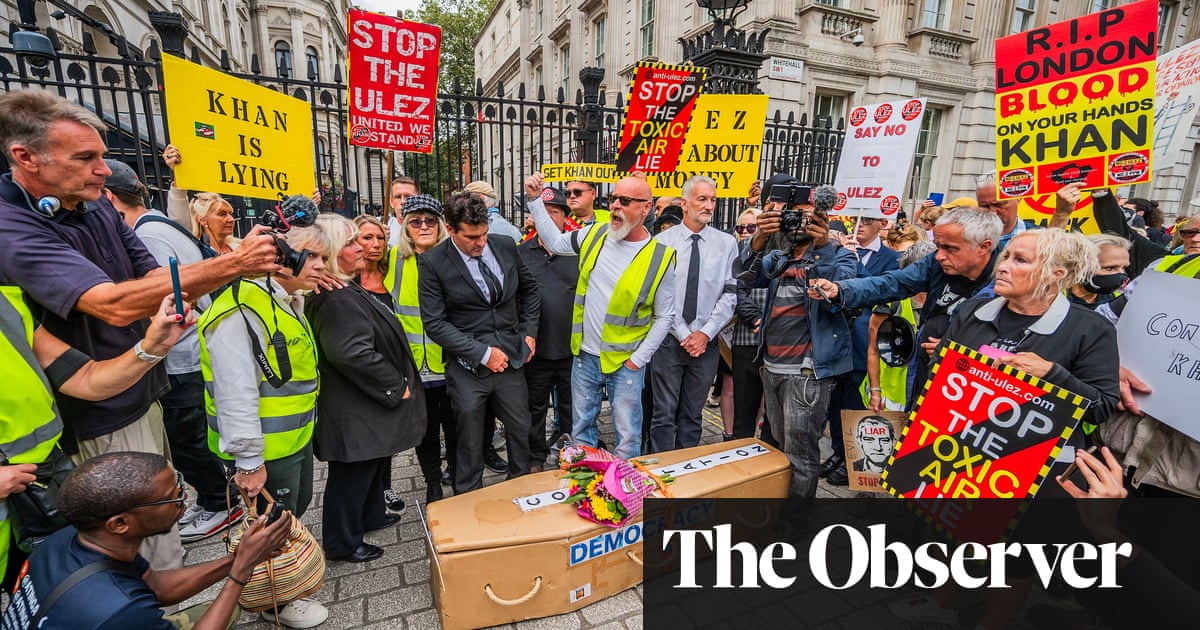
There are clues to their existence in street names, in the winding of lanes and in the rushing sound of water deep in the capital’s drains. For centuries London has been sculpted by its rivers. Today, though, while vestiges of some remain visible, most lie buried beneath pavements and submerged in the sewage system.
Now the Ramblers walking charity is calling for a network of new green walking routes tracing the paths of some of London’s “forgotten” waterways. It wants the mayor to back plans for signage and maps to guide walkers around these historic subterranean routes.
“We have the London Loop, the Capital Ring and the Thames path. But we don’t have many radial routes that come back in or back out of London. The hidden rivers are really good radial walks,” said Des Garrahan, of Inner London Ramblers, who leads guided walks on London’s buried rivers.
The ridge of Hampstead Heath contains the headwaters of four London rivers – the Brent, the Westbourne, the Tyburn and the Fleet.
Paul Talling covers 22 rivers in his book and on his website, London’s Lost Rivers. “But there are lots of little tributaries that feed them. So we’re talking scores and scores of lost waterways in London,” said Talling, who also leads guided lost river walks.
As London’s population expanded, rivers became open sewers, heavily polluted and foul-smelling. By the 1820s, most had been covered over. By the 1860s, following the Great Stink of 1858, most were incorporated into Joseph Bazalgette’s sewer system.
“Before that, London really was a river city,” said Talling. “They were used for market gardening. There were mills. There was a mill at Clerkenwell, where the well was used by clerks of the nunnery, and myriad little underground springs that fed the well. There’s Sadler’s Wells. The clues are there in the names.”
The Fleet, flowing from Hampstead to Blackfriars, is the best known. The Tyburn branched to form islands, on one of which, Thorney Island, Westminster Abbey now stands. The Effra can still be seen at a storm outfall outside the MI6 building near Vauxhall.
“They are forgotten. The average person walking around London doesn’t know about them,” said Talling. “People should be aware of what’s beneath their feet. They say look up, but I always say look down, listen to the drains, look at the street names.”
An exhibition at the Museum of London in 2019 traced the history of many of the secret rivers. Its co-curators, Kate Sumnall and Thomas Ardill, said at the time: “Polluted and neglected, some of the rivers disappeared underground, but they are not entirely lost or forgotten. Some continue to flow as sewers and drains, and their traces can be seen throughout modern London in placenames, the shaped of streets and boundaries, and in the placement of buildings and landmarks.”
Among the routes proposed by the Ramblers is one following the course of the Fleet down to the Thames past St Pancras Old Church and alongside Regent’s canal. The Silk Stream trail links Hampstead Heath to the London Loop at High Barnet, and the Counter’s Creek route follows the path of a hidden river along the boundary between Hammersmith and Fulham and Kensington and Chelsea, taking in two cemeteries at Kensal Green and Brompton and linking up with the Thames path, Putney and Wimbledon Commons, the Capital Ring and the London Loop.
Phil Marson, the vice-chair of the Inner London Ramblers, said: “The last year has shown how essential access to quality outdoor space is to Londoners’ health and fitness, and illuminated the importance of the city’s ‘green lungs’ – from the city centre to its rural fringes.
“Making great walking routes easier to find and use, and making them part of Londoners’ everyday lives, is an essential part of building a sustainable post-pandemic recovery, connecting to other transport and enabling active travel and leisure. Therefore we’re calling on the next London mayor to add six new strategic routes, improve and promote the existing ones, and measure their use, in the way that the GLA does for other modes of transport.”
London’s top hidden rivers
The Fleet Polluted by industry and carcasses from Smithfield’s butchers, this foul-smelling waterway was a blight on London and bordered by slums. Fagin’s Den in Dickens’ Oliver Twist was set here. The author Ben Johnson (1572-1637) likened it to the Styx in hell. After the 1858 Great Stink, sections were incorporated into Joseph Bazalgette’s sewage system. The sound of its rushing water can still be heard through some manholes.
The Tyburn Also originating in Hampstead, the stretch through Regent’s Park to Pimlico was once a prime salmon fishing stream. The Tyburn Angling Society’s proposals to restore it have not come to fruition, possibly because it could mean the demolition of Buckingham Palace. The reason Marylebone Lane isn’t straight is that it followed the course of the Tyburn.
The Walbrook Long since covered over, Roman Londinium grew up along its banks. It ran under the Roman London wall.
The Westbourne George’s II’s wife, Queen Caroline, ordered it be dammed to form the Serpentine and prettify Hyde Park in 1730. Remains still flow through a pipe above Sloane Square tube station.
The Effra Earth excavated during its enclosing was used to build the raised banks at the Oval cricket ground. Torrential rainfall led to sewers overflowing which flooded the cricket ground in the 1950s. In 1992 there were spoof proposals to bring the buried Effra back to the surface, with posters reading “Wet, Dark and Buried”. It still remains buried, as a storm drain serving a stretch of south London from Norwood to Vauxhall.












